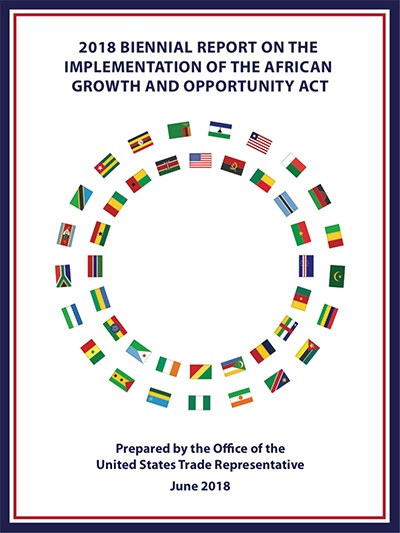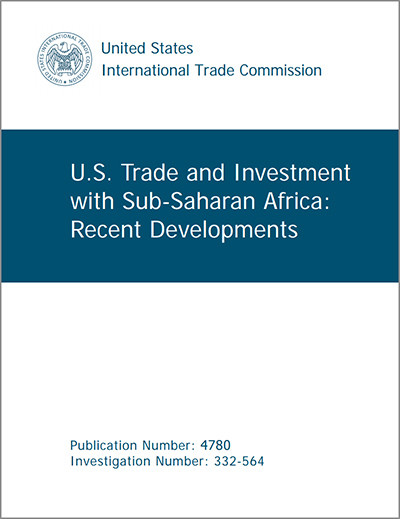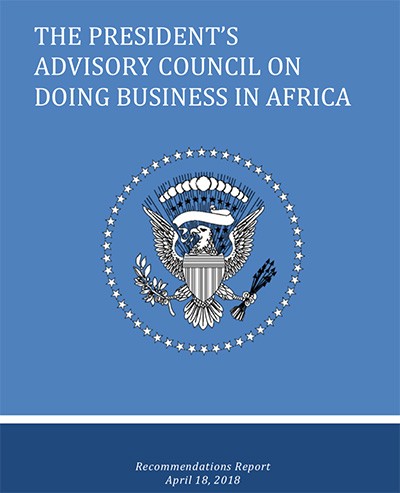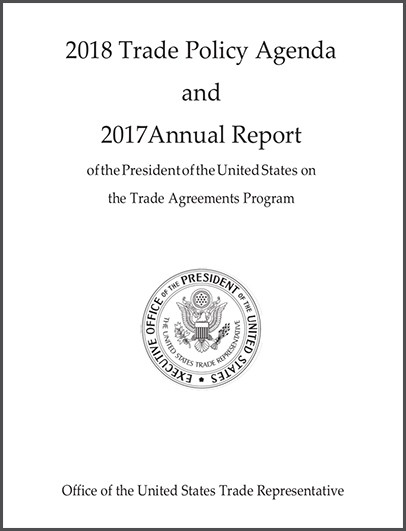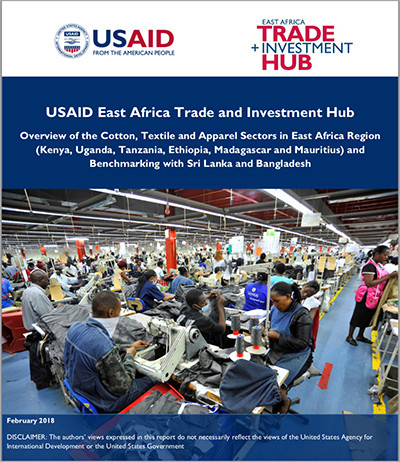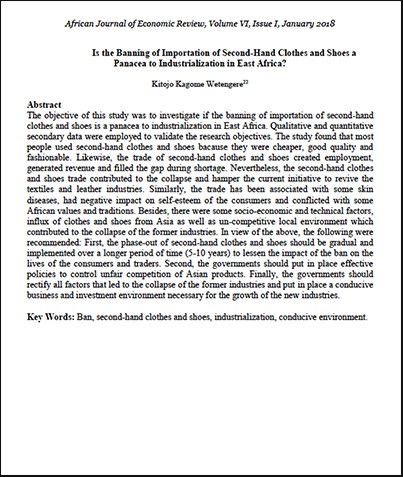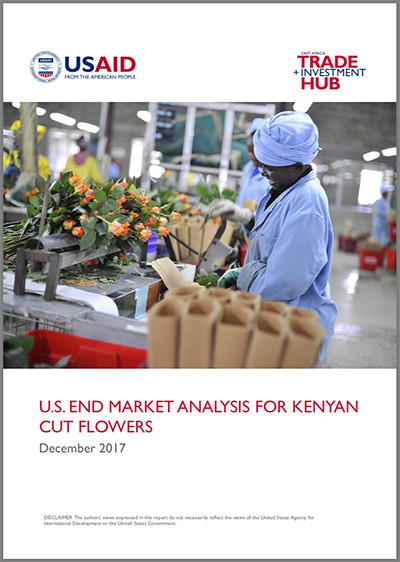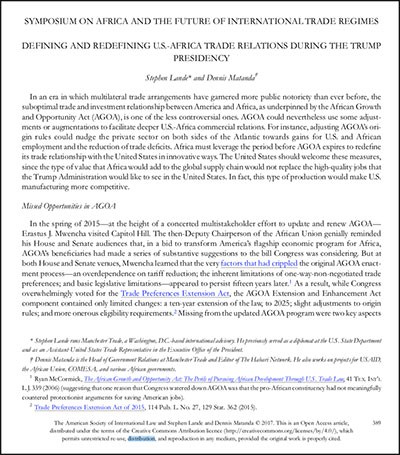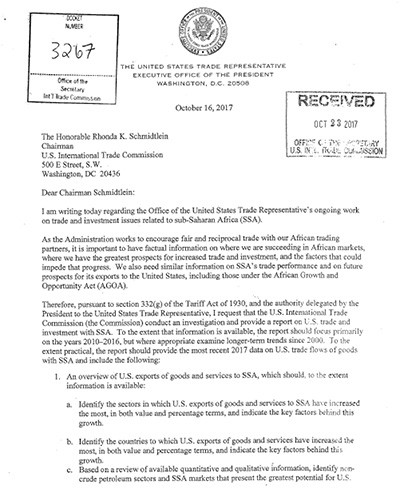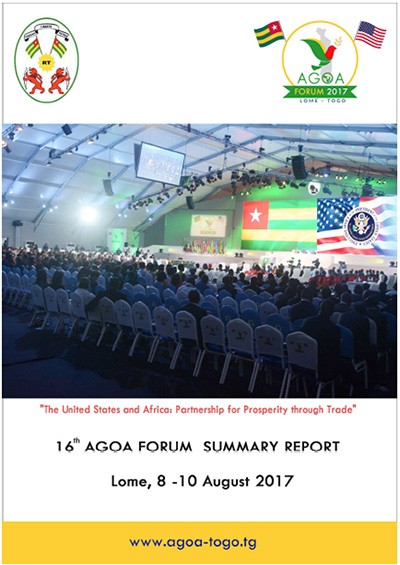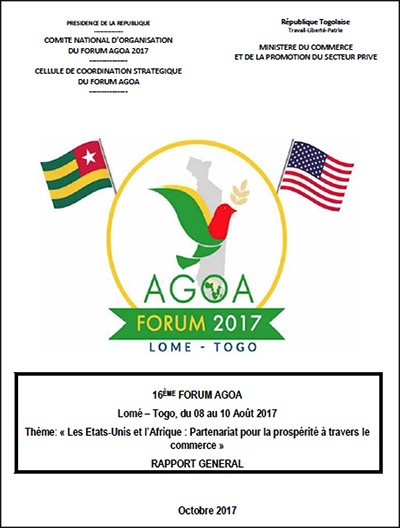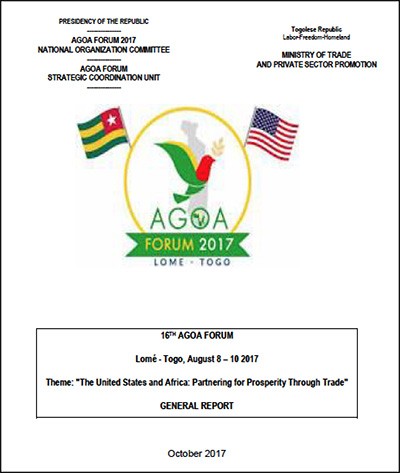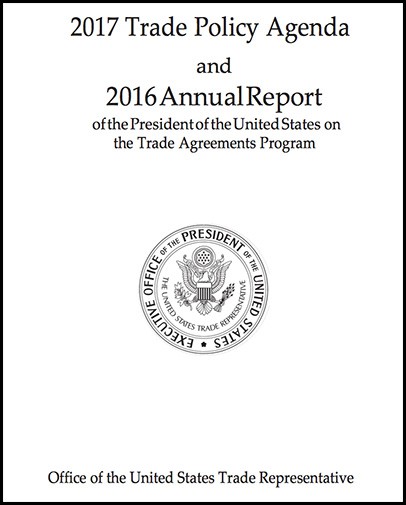General Documents
2018 AGOA Implementation Report
Section 110 of the Trade Preferences Extension Act of 2015 (“the Act”), 19 U.S.C. § 3705 note, states that the President1 shall submit a report to Congress on the trade and investment relationship between the United States and sub-Saharan African countries no later than one year after the enactment of the Act, and biennially thereafter. The U.S. Trade Representative, on behalf of the President, submitted the first report under this provision in June 2016. The current report covers the period since then. It provides a description of the status of trade and investment between the United States and sub-Saharan Africa, changes in country eligibility for AGOA benefits, an analysis of country compliance with the AGOA eligibility criteria, an overview of regional integration efforts in sub-Saharan Africa, and a summary of U.S. trade capacity building efforts.
AGOA 101 Kenya - Exporter Guide 2018
The USAID East Africa Trade and Investment Hub helps East African businesses take advantage of the African Growth and Opportunity Act (AGOA). AGOA allows for duty-free export of over 6,000 products. This guide outlines the step-by-step process that Kenyan businesses should take to export to the United States of America (U.S.A.) duty-free through AGOA and gives a general overview for the export of all AGOA products from Kenya. It provides additional information on the export of four high-demand, high-value sectors, namely textiles and apparel; coffee; nuts and oil crops; and cut flowers. Although exporting can be a challenging process, it can also be profitable for the individual or company that successfully complies with the steps. Exporters must follow two sets of requirements: Kenyan laws and regulations that govern the export process, and Laws and regulations that govern the destination country’s imports, in this case, the U.S.A. Regulations also vary according to the product being exported; exporters must research to ensure that their product meets the necessary requirements for export. This guide assumes that the exporter or potential exporter has already conducted the necessary market research, and is ready to export. Before proceeding, exporters must identify the correct tariff code and its eligibility for dutyfree export under AGOA. This status can be established by referring to...
US trade and investment with Africa: recent developments
This report was prepared by the U.S. International Trade Commission (Commission) at the request of the U.S. Trade Representative (USTR) in a letter received by the Commission on October 23, 2017. The USTR requested that this report provide information on the sectors in which U.S. trade in goods and services with sub-Saharan Africa (SSA) showed the fastest growth during the period 2010–16; highlight the key factors behind that growth; and identify the sectors and SSA markets that present the greatest potential for U.S. trade and foreign direct investment (FDI) with SSA. Further, the report describes exports of goods and services from U.S. small and medium-sized enterprises (SMEs) to SSA, provides country profiles of seven SSA countries, and summarizes SSA countries’ AGOA utilization strategies as well as the status of regional integration efforts.
The President's Advisory Council on doing business in Africa
The President’s Advisory Council on Doing Business in Africa advises the President, through the Secretary of Commerce, on ways to strengthen commercial engagement between the United States and Africa. Members receive no compensation for their efforts on the Council. This report was prepared by the private-sector members of the Council. The views expressed in this report do not necessarily reflect those of the Administration or individual members of the Council.
2018 Trade Policy Agenda and 2017 Annual Report
The 2018 Trade Policy Agenda and 2017 Annual Report of the President of the United States on the Trade Agreements Program are submitted to the Congress pursuant to Section 163 of the Trade Act of 1974, as amended (19 U.S.C. 2213). Chapter V and Annex II of this document meet the requirements of Sections 122 and 124 of the Uruguay Round Agreements Act with respect to the World Trade Organization. In addition, the report also includes an annex listing trade agreements entered into by the United States since 1984. Goods trade data are for full year 2017. Services data by country are only available through 2016.
Overview of the Cotton, Textile and Apparel Sectors in East Africa Region and Benchmarking with Sri Lanka and Bangladesh
Overview of the Cotton, Textile and Apparel Sectors in East Africa Region and Benchmarking with Sri Lanka and Bangladesh is a USAID Hub report that serves as a reference for businesses looking to source from East Africa. It provides easily searchable and mapped information on sector players that could be used to identify textile, apparel and apparel accessory producers who can supply products to local and regional clients and U.S. buyers. It also benchmarks the business climate for apparel-related trade and investment in six East African countries (Kenya, Uganda, Tanzania, Madagascar, Mauritius and Ethiopia) against two global apparel producing competitors in Asia – Sri Lanka and Bangladesh – to provide a basis for the selection of suitable sourcing and investment for local and global buyers as well as policy improvements and interventions by East African governments.
Is the banning of importation of second-hand clothes and shoes a panacea to industrialization in East Africa?
The objective of this study was to investigate if the banning of importation of second-hand clothes and shoes is a panacea to industrialization in East Africa. Qualitative and quantitative secondary data were employed to validate the research objectives. The study found that most people used second-hand clothes and shoes bacause they were cheaper, good quality and fashionable. Likewise, the trade of second-hand clothes and shoes created employment, generated revenue and filled the gap during shortage. Nevertheless, the second-hand clothes and shoes trade contributed to the collapse and hamper the current initiative to revive the textiles and leather industries. Similarly, the trade has been associated with some skin diseases, had negative impact on self-esteem of the consumers and conflicted with some African values and traditions. Besides, there were some socio-economic and technical factors, influx of clothes and shoes from Asia as well as un-competitive local environment which contributed to the collapse of the former industries. In view of the above, the following were recommended: First, the phase-out of second-hand clothes and shoes should be gradual and implemented over a longer period of time (5-10 years) to lessen the impact of the ban on the lives of the consumers and traders. Second, the governments should put in place effective policies to control unfair competition of Asian products....
US end-market analysis for Kenyan textiles and apparel
The apparel market in the United States (U.S.) is the largest in the world with a market value of $343 billion. In 2016, the U.S. imported apparel worth $105 billion, up from $88 billion in 2015 and $82 billion in 2014.1 U.S. consumers spent $312 billion on apparel. Ten countries account for almost 80 percent of all U.S. apparel imports with China topping the list with a 30 percent share. While Kenya does not yet stand among these countries, there is an opportunity for Kenya to take advantage of its trade preferences under the African Growth and Opportunity Act (AGOA) to increase its exports to the U.S. market. Since AGOA was signed for an additional ten-year term in 2015, there has been a growing trend toward sourcing and importing apparel to the U.S. If more stakeholders in both countries realize AGOA’s full potential, Kenyan apparel exports can continue to climb. This report focuses on six target product opportunities for Kenyan exporters: Knitted Shirts in Synthetics for all genders and ages T-shirts in Cotton and Synthetic for all genders and ages Sweaters in Synthetic for all genders and ages Woven Pants and Shorts in Cotton and Synthetic for all genders and ages Woven Shirts in Cotton and Synthetic for all genders and ages Dresses for Women and Girls in Cotton and Synthetic as part of SME products These products were determined by volumes and trends and are not unique to Kenyan production. However, these products offer opportunities for large duty...
US end-market analysis for Kenyan cut flowers
Cut flowers are a major export industry in Kenya. Kenya presently ranks first among world exporters of roses to the European Union (EU), with a market share of 38 percent. However, the country has not yet made as deep of inroads into the cut flower market in the United States (U.S.). Kenyan cut flower exports to the U.S. have grown since 2010, but the country’s market share remains small, standing at 1 percent. This report analyzes emerging opportunities to increase Kenyan flower exports to the U.S. while taking advantage of the benefits granted under the African Growth and Opportunity Act (AGOA). In 2016, Kenya ranked as the twelfth greatest supplier of cut flowers to the U.S. Nearly 90 percent of the cut flowers imported by the U.S. come from three countries: Colombia (59 percent), Ecuador (22 percent) and the Netherlands (7 percent). Colombia and Ecuador, who make up more than 80 percent of the imported flowers, present stiff competition. The countries profit from longstanding commercial relationships with the U.S. and geographic proximity, which reduces freight and transport costs. Both countries enjoy duty-free access to the U.S. market, as does Kenya. Nonetheless, Kenya has a strong, competitive cut flower industry that is ready to explore new markets. The industry is profitable and technically competent, it has developed efficient logistics to the European markets and it offers high-quality flowers at competitive prices. If the industry can use these strengths...
US end-market analysis for Kenyan home decor and fashion accessories
This report provides market data at a product level for use by Kenyan exporters interested in the United States (U.S.) market and to support the National African Growth and Opportunity Act (AGOA) Strategy and Action Plan for Kenya. The home décor and fashion accessories sector has the capacity to further the goals of increasing women and youth participation in manufacturing by providing greater access to economic opportunities. In 2016, the top preforming Kenyan product categories in this sector represented $5.2 million in exports to the U.S. The U.S. is the largest importer in the world in all categories, and the fourth largest in jewelry. This report analyzes the top supply growth opportunities for Kenya based on the U.S. import demand. It also presents the current market trends in the U.S. for Kenya to better compete internationally. In addition, the Kenya Vision 2030 makes the recommendation for "a better and more inclusive wholesale and retail trade sector." Accomplishing the goal of increasing efficiency, lowering transaction costs and strengthening trade as well as linking trade to wider local and global markets requires: Understanding the demands of the international market and the trends that influence the global exports to the U.S. market; Understanding the advantages of the Kenyan market in key product categories, competitiveness in raw material sourcing, and the international competitors participating on the global stage; Sharing a detailed explanation...
Defining and redefining US-AFRICA trade relations during the Trump Presidency
In an era in which multilateral trade arrangements have garnered more public notoriety than ever before, the suboptimal trade and investment relationship between America and Africa, as underpinned by the African Growth and Opportunity Act (AGOA), is one of the less controversial ones. AGOA could nevertheless use some adjustments or augmentations to facilitate deeper U.S.-Africa commercial relations. For instance, adjusting AGOA’s origin rules could nudge the private sector on both sides of the Atlantic towards gains for U.S. and African employment and the reduction of trade deficits. Africa must leverage the period before AGOA expires to redefine its trade relationship with the United States in innovative ways. The United States should welcome these measures, since the type of value that Africa would add to the global supply chain would not replace the high-quality jobs that the Trump Administration would like to see in the United States. In fact, this type of production would make U.S. manufacturing more competitive.
USTR request letter - Investigation into US-SSA trade
Request letter concerning USTR / USITC investigation into US trade with Sub-Saharan Africa.
AGOA Forum 2017: Brochure and Photos
AGOA Forum 2017 Brochure and Photo Report prepared by the 2017 Togo AGOA Forum Organising Committee.
AGOA Forum 2017: General Report on the AGOA Forum in Togo (french)
Very comprehensive summary and feedback report prepared by the 2017 Togo AGOA Forum Organising Committee. This report is in french.
AGOA Forum 2017: General Report on the AGOA Forum in Togo (english)
Very comprehensive summary and feedback report prepared by the 2017 Togo AGOA Forum Organising Committee.
2017 trade policy agenda and 2016 annual report of the president of the United States on the trade agreements program
On March 1, 2017, the Office of the U.S. Trade Representative (USTR) posted the 336 page 2017 Trade Policy Agenda and 2016 Annual Report of the President of the United States on the Trade Agreements Program. The reports are required to be submitted to the U.S. Congress by March 1, pursuant to Section 163 of the Trade Act of 1974, as amended (19 U.S.C. 2213). Chapter II and Annex II of the document are intended to meet the requirements of Sections 122 and 124 of the Uruguay Round Agreements Act with respect to the World Trade Organization. In addition, the report also includes an annex listing trade agreements entered into by the United States since 1984. Goods trade data are for full year 2016. Services data by country are only available through 2015. The Office of USTR states that it intends to submit a more detailed report on the President’s Trade Policy Agenda after the Senate has confirmed a USTR, and that USTR has had a full opportunity to participate in developing such a report. The Trade Policy Agenda portion outlines the trade policy objectives and priorities of the United States for 2017, and reasons therefor. The Agenda states that, “The overarching purpose of our trade policy – the guiding principle behind all of our actions in this key area – will be to expand trade in a way that is freer and fairer for all Americans.” It lists the following key objectives: Ensuring that U.S. workers and businesses have a fair opportunity to...


